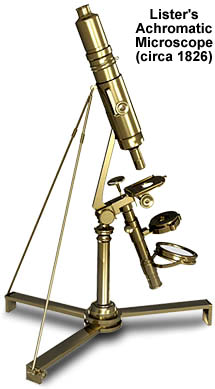Lister's Achromatic Microscope
Joseph J. Lister was a British scientist who played a critical role in the early development of the achromatic lens. He designed this microscope and commissioned W. Tulley to build a prototype in 1826.

Tulley, in turn, gave the plans to an instrument maker named James Smith, who completed the microscope in May of 1826. This microscope deviated from other instruments of the period in that Lister did not provide for conversion of the microscope to a single-lens apparatus. Perhaps due to the confidence of Lister in the achromatic design, the microscope was constructed to be operated only as a compound microscope. The stage is capable of a full range of movements precisely controlled by rack and pinion gears, and there is a substage pillar to which the compound condenser and reflector are mounted. A set of struts running between the body tube and the tripod stand adds stability to the microscope. The eyepiece is mounted in a threaded mount, an advanced feature for the time period. Another unusual feature of this microscope is the lack of a fine focus mechanism. Instead, it relied on a very smooth operation of the main rack work to focus its relatively high numerical aperture objective lens.
BACK TO NINETEENTH CENTURY MICROSCOPES
